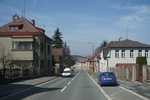CZ: Červený Kostelec

All such picturesque countryside, with its forests and ponds of Špinka and Brodský belongs to great temptations for numerous tourists.
History
 The first notice about Červený Kostelec comes of 22nd August 1362, mentioning the nomination of Herman, priest, to Kostelec parsonage. The name „Kostelec“ was derived from Latin word of „castellum“, what means castle or stronghold. Hynek younger from Dubá was an owner of Kostelec dominion during Hussite time period, but the inhabitants were mostly on Hussiten side. Later, in the middle of 15th century, Kostelec formed a part of Vizmburg dominion, however, Vizmburg was destroyed by Silesians in 1447. Since 1497, this small town belonged to Náchod manorial estate. Anyway, one hundred years later, the inheritor of Sendražice Family bequeathed the forests, meadows and fields to parsonage, Kostelec stronghold was pulled down and all stones used for the reconstruction of wooden church (this bulding burnt out in 1591, together with a part of the town and communal and parish documents. Only tin baptismal font of 1555 was saved. So, at present, this object belongs to the oldest material monuments of the town.
The first notice about Červený Kostelec comes of 22nd August 1362, mentioning the nomination of Herman, priest, to Kostelec parsonage. The name „Kostelec“ was derived from Latin word of „castellum“, what means castle or stronghold. Hynek younger from Dubá was an owner of Kostelec dominion during Hussite time period, but the inhabitants were mostly on Hussiten side. Later, in the middle of 15th century, Kostelec formed a part of Vizmburg dominion, however, Vizmburg was destroyed by Silesians in 1447. Since 1497, this small town belonged to Náchod manorial estate. Anyway, one hundred years later, the inheritor of Sendražice Family bequeathed the forests, meadows and fields to parsonage, Kostelec stronghold was pulled down and all stones used for the reconstruction of wooden church (this bulding burnt out in 1591, together with a part of the town and communal and parish documents. Only tin baptismal font of 1555 was saved. So, at present, this object belongs to the oldest material monuments of the town.
However, another disaster approached, which stroke not only the town but all Bohemia - it was Thirty Years´ War. The inhabitants´ number dropped to two hundred persons, and only one four th of fields was cultivated. At that time, Kostelec was declared as market-town. This fact is confirmed by seal of 1680, where you can follow the oldest picture of town´s escutcheon. In 1668, the church undergone a reconstruction. However, later, within 18th century, the construction was destroyed, and between 1744-1754, new St. James Baroque church was built. The Knight Octavio Piccolomini became its patron. Charles Ignatius Dientzenhofer, famous architect, participated on the construction, too (it is an author of Clementinum Mirror Chapel, main frontal facade of Loreta Church in Prague, or St. Nicholas Benedictines´ Order Monastery in Old Town Square, etc.) However, against the original idea, the church navy was shortened, and the second church tower was not erected at all.
th of fields was cultivated. At that time, Kostelec was declared as market-town. This fact is confirmed by seal of 1680, where you can follow the oldest picture of town´s escutcheon. In 1668, the church undergone a reconstruction. However, later, within 18th century, the construction was destroyed, and between 1744-1754, new St. James Baroque church was built. The Knight Octavio Piccolomini became its patron. Charles Ignatius Dientzenhofer, famous architect, participated on the construction, too (it is an author of Clementinum Mirror Chapel, main frontal facade of Loreta Church in Prague, or St. Nicholas Benedictines´ Order Monastery in Old Town Square, etc.) However, against the original idea, the church navy was shortened, and the second church tower was not erected at all.
In 1867, Kostelec was declared as a town. Emperor-Kingdom Ministry of Trade allowed the town  its attribute „Červený“ („Red“). The number of inhabitants increased. In 1880, the town had nearly 2700 persons, and its number arrived at 4400 persons in 1910. Before, in 1861, a post-office was built there, credit-bank one year later, followed by town´s saving´s bank. In 1869, the pharmacy appeared there, and since 1874, the town got its doctor´s surgery room, too. Even the education was supported. Since 1882 an independent girls´ building was established, and one year later (in 1887), upper elementary school for girls was open.
its attribute „Červený“ („Red“). The number of inhabitants increased. In 1880, the town had nearly 2700 persons, and its number arrived at 4400 persons in 1910. Before, in 1861, a post-office was built there, credit-bank one year later, followed by town´s saving´s bank. In 1869, the pharmacy appeared there, and since 1874, the town got its doctor´s surgery room, too. Even the education was supported. Since 1882 an independent girls´ building was established, and one year later (in 1887), upper elementary school for girls was open.
 After Velvet Revolution in 1989, all services, shops, small companies and big industrial factories were privatized: The town constructed cleaning centre for fall waters. Shortly afterthat, Czech as well as foreign capital started to come to the towan, which became a base for construction of buildings with spaces available for residence as well as for relax in western industrial zone. At present, Červený Kostelec is, similarly as in past, an important starting point for excursions into picturesque environs, following dense nest of tourist routes and cycling paths.
After Velvet Revolution in 1989, all services, shops, small companies and big industrial factories were privatized: The town constructed cleaning centre for fall waters. Shortly afterthat, Czech as well as foreign capital started to come to the towan, which became a base for construction of buildings with spaces available for residence as well as for relax in western industrial zone. At present, Červený Kostelec is, similarly as in past, an important starting point for excursions into picturesque environs, following dense nest of tourist routes and cycling paths.
Places of Interest in Červený Kostelec
St. Wenceslas Statue (1929)
A statue of the greatest Bohemian Saint is placed at right part, in front of main entrance into St. James Church, on elevated footing of square ground-plan. St. Wenceslas has a crown on his head, and his left hand is reposing on his breast, whereas the right one is supported on a shield with a sign.
St. Ludmila Statue (1933)
At left side of St. James Church, you can see a statue of St. Ludmila, a grandmother of St. Wenceslas. The figure was created in larger then lifesize, and all her body is veiled in rich drapery.
Božena Němcová House
In Božena Němcová Street, a memorable plate is to be found on house No. 127, informing the visitors that this famous woman-writer lived there.
„Just opposite the parsonage, a house was placed which was different with clean arrangement.  The whole front facade was snow white. At the windows, summer green shutters were placed, and main door was brown, secured with glassed windows. Behind this glassed door, various things were to be seen, such as: ribbons, spindles, painted tubes, pipes, figs, balls, so, all things, giving evidence that this is merchant´s flat. The house was bordered with small wall around and filled in with white paving-stones. The wall was projected six feet into the road, and two stages led there from each side. So, this house proved as ideal for staying there“. (Božena Němcová: Chudí lidé - Poor Persons).
The whole front facade was snow white. At the windows, summer green shutters were placed, and main door was brown, secured with glassed windows. Behind this glassed door, various things were to be seen, such as: ribbons, spindles, painted tubes, pipes, figs, balls, so, all things, giving evidence that this is merchant´s flat. The house was bordered with small wall around and filled in with white paving-stones. The wall was projected six feet into the road, and two stages led there from each side. So, this house proved as ideal for staying there“. (Božena Němcová: Chudí lidé - Poor Persons).
During the war, a small „Božena Němcová Room“ was open for public, which was later, in 1962, new arranged, on the occasion of 100th anniversary of the writer´s death. In 1985, complete reconstruction of the house was effected, and new exhibition about the town´s history was installed there. So, in ground floor, you can see small kitchen with cockle-stove, historical furniture, small pictures, various subjects of past time or the equipment for house linen spinning.
Town Hall
 Originally, it is stone house which belonged to mayor. At the beginning of 19th century, the building was increased in one stage by Mr. Davide Vikolcil, and covered with garret roof with shingle. In the first floor, the proprietor arranged his luxurious flat and linen-dealer shop in ground-floor. However, Vikolcil Family bankrupted after several years. Several other owners were changed in the meantime, and finally, in 1882, the house was acquired in auction by the town. The town´s representatives arranged there town hall, which was operating there shortly after the 2nd World War. After total reconstruction, effected during 1990, the building got its Neo-Baroque face, and became Town Hall again.
Originally, it is stone house which belonged to mayor. At the beginning of 19th century, the building was increased in one stage by Mr. Davide Vikolcil, and covered with garret roof with shingle. In the first floor, the proprietor arranged his luxurious flat and linen-dealer shop in ground-floor. However, Vikolcil Family bankrupted after several years. Several other owners were changed in the meantime, and finally, in 1882, the house was acquired in auction by the town. The town´s representatives arranged there town hall, which was operating there shortly after the 2nd World War. After total reconstruction, effected during 1990, the building got its Neo-Baroque face, and became Town Hall again.
St. James Church
The church is remembered just in the first notice of 1362 as parish building. However, during big fire in 1591, the building was destroyed and renewed even in the second half of 17th century. Later, within 1744-1754, the reconstruction in Baroque style was effected. One-navy church could be proud on wealthy decorated frontal facade, dominating with St. James statue. Till 1940, the church was missing the second tower (during Baroque time reconstruction the grounds were put there). Within 1939-1940, the tower was terminated into its original height and finished with Neo-Baroque cupola of onion shape which was put on the top. The internal church decoration does not follow the Baroque style. The altar of Renaissance style was created in 1906, portal statue altars of St. John Nepomuk and Virgin Mary are of Baroque style. Inside, you can admire most valuable monument - tin baptismal font of 1555.
Calvary Group of Statues (middle of 18th century)
Inside St. James Church, you can admire also Calvary Group of Statues, dominating with a Cross of crucified Saviour. Along side parts of the cross, small statues, presenting Virgin Mary Mater Dolorosa and St. John the Evangelist. Both figures are looking up the cross.
 At the road, from the square in direction to Náchod, you can admire another Calvary Group of Statues. On four-part stage base, massif footing is to be found, provided with decorated ornaments along both sides. The footing is terminated with profiled cornices. On elevated stand, a cross with crucified Saviour is to be found, along both parts of the cross, two small statues – Virgin Mary Mater Dolorosa and St. John the Evangelist are placed. Both statues are looking up the cross in moderate spiral movement. At foot of the cross, skull plastic art is situated. The group of statues is made from rough-grained sandstone, and was created in the middle of 18th century, probably later that Virgin Mary Column. However, we do not know the author´s name.
At the road, from the square in direction to Náchod, you can admire another Calvary Group of Statues. On four-part stage base, massif footing is to be found, provided with decorated ornaments along both sides. The footing is terminated with profiled cornices. On elevated stand, a cross with crucified Saviour is to be found, along both parts of the cross, two small statues – Virgin Mary Mater Dolorosa and St. John the Evangelist are placed. Both statues are looking up the cross in moderate spiral movement. At foot of the cross, skull plastic art is situated. The group of statues is made from rough-grained sandstone, and was created in the middle of 18th century, probably later that Virgin Mary Column. However, we do not know the author´s name.
A Cemetery and St. Cyril and Method Chapel
The cemetery (valued as one of most beautiful in the Czech Republic) is situated on the top of small Chrby hillock not far from city centre, and it is free continuation of Smetana Park. The tombs, where many important town´s natives were set aside, are kept always with fresh flower decoration. Basic stone to the construction of St. Cyril and Method Chapel was put in 1862, and its construction was terminated in 1865. The interior is decorated with two pictures of Virgin Mary Mater Dolorosa on the altar, and Virgin Mary with Jesus Baby. In 2005, complete reconstruction, including Croce Dolorosa route and paving of main path, was effected.
Viktorka´ s Tomb
 In Dvořáčkova Street, which leads from the church towards new cemetery, a symbolic tomb of mad Viktorka is placed. Viktorka is a figure from famous novel „Babička“ (The Grandmother) written by Božena Němcová.
In Dvořáčkova Street, which leads from the church towards new cemetery, a symbolic tomb of mad Viktorka is placed. Viktorka is a figure from famous novel „Babička“ (The Grandmother) written by Božena Němcová.
So, at forged cross, you can read on plate the following inscription:
„Here, there is buried Viktorka, born in 1792, a daughter of Anthony Žid from Červená Hora. She died on 17th Ocrtober 1868. Viktorka Židova was found half-dead in small cave in oak-grove close to Žernov, and transported to her native Červená Hora. After her death, she was buried, under municipal costs, on 19th October 1868, into common tomb for poor persons in Kostelec cemetery, as community of Červená Hora belonged to local parsonage. According to death certificate, she died on 18th October in the age of 76 years, decrepited.“
Text: Maxim Kucer
Translation: ing. Jan Jonáš
Photo: Mck.cz
| Discussion at the article (0) |
Related Articles

CZ: Kamenice nad Lipou – The City of Ancient Trie
Guide:
Important Information:
![]() Information and warnings on travelling abroad is to be found HERE.
Information and warnings on travelling abroad is to be found HERE.

























